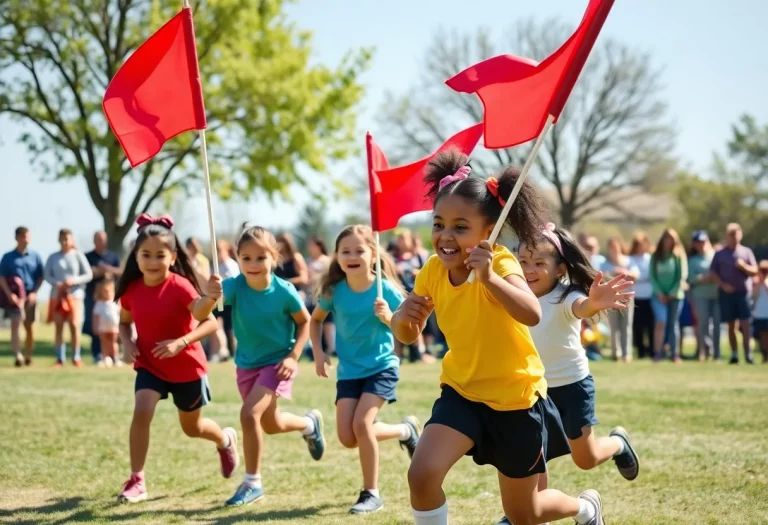News Summary
Girls flag football is witnessing a surge in popularity across the United States, supported by the NFL and expanding at high school and college levels. With new teams and leagues forming, this sport aims to become a mainstream choice for female athletes. Currently, nine states have implemented girls flag football, and more are considering it, reflecting a growing trend towards inclusion in sports. Colleges like Lakeland and Marian University are leading the way in this expansion, with potential recognition as an NCAA sport on the horizon.
Girls Flag Football Gains Momentum Across the U.S.
In cities across the United States, girls flag football is experiencing an impressive surge in popularity, with high school and college teams springing to life. This growth isn’t just a passing trend; many believe it’s setting the stage for flag football to become a mainstream sport.
Support from the NFL Fuels Excitement
The support from the NFL has played a significant role in championing girls and women’s flag football. With initiatives that provide resources for high school teams, like training camps and equipment grants, the NFL is making it easier for schools to dive into this exciting sport. Their efforts reflect a larger goal of broadening the appeal of football to girls and underrepresented communities.
A High School Phenomenon
At the high school level, the enthusiasm is tangible. Coaches and athletic directors across the country are noticing a booming interest. For instance, in Wisconsin, there are now at least two ad hoc leagues; one prominently features teams within the Classic 8 Conference. While official discussions by the Wisconsin Interscholastic Athletic Association (WIAA) on sanctioning flag football are yet to take place, plans are in the works. By Spring 2025, the WIAA might be ready to take a more serious look at this growing sport.
Currently, nine states are offering girls flag football for the upcoming 2024-25 school year, with two more states eager to add it to their athletic programs. Seventeen additional states are also considering the sport, illustrating a national trend toward inclusion and growth in girls’ athletics.
College-Level Expansion
The college scene is equally vibrant, with the NAIA reporting 23 teams that participated in women’s flag football for the 2025 spring season. This number is expected to rise by one-third in the 2025-26 school year, making it a fast-developing competitive arena. In addition, over 65 NCAA schools are currently sponsoring women’s flag football at club or varsity levels. This push at the collegiate level could soon see flag football recognized as an official NCAA emerging sport, following discussions that could lead to a national championship for women athletes.
As part of the plan, Lakeland University and Marian University in Wisconsin are gearing up to introduce women’s flag football as an intercollegiate sport starting in 2026. These institutions will be the first four-year colleges in the state to welcome women into the flag football fold, bolstered by the involvement of former NFL players who help generate excitement for the sport.
The Growth of the Game
Flag football has a rich history, originating during World War II for recreational purposes, and has now evolved into a dynamic form of the sport characterized by its low-contact nature. The game is played without tackling, using flags to mark when a player is down, which can be particularly appealing for younger players or those new to the game.
Interestingly, the game is poised to gain even more international recognition as both men’s and women’s flag football have been slated to be included in the 2028 Los Angeles Olympics. Variations of the game, such as six-on-six and seven-on-seven, are also set to showcase the versatility and adaptability of flag football.
A Welcoming and Inclusive Environment
The local flag football teams are thriving under these recent developments. At teams like Kettle Moraine’s, interest has surged, with around 50 girls initially showing interest, half of whom participated during their inaugural season. These teams are not just focusing on the competition but also creating an inviting atmosphere where newcomers can learn and grow, reflecting a shift towards a more inclusive approach in athletics.
However, challenges remain. The introduction of flag football across varied school schedules has raised logistical hurdles, prompting discussions about aligning the seasons to facilitate smoother play across different regions. While the WIAA aims to recognize flag football as an official sport if at least five percent of member schools are participating, a championship tournament would require a higher threshold of ten percent.
Looking Ahead
With increasing support from key organizations and a palpable enthusiasm among players and coaches alike, the trajectory of girls flag football looks promising. It offers a chance for many girls who may not have had the opportunity to play traditional sports, all while carving a path for future champions. It’s clear that flag football is here to stay, and communities are embracing its spirited promise!
Deeper Dive: News & Info About This Topic
LIVE BALL Resources
Debate Over Transgender Athlete’s Victory in Naperville
La Porte Unveils $56 Million High School Football Stadium
Kansas High School Softball Stars Shine in 2025 Season Finale
Aubrey Wilson Leads Divine Child Girls’ Track Team to Championship
Iowa High School Baseball Season Set to Begin
Notre Dame-West Burlington Clinches SEI Super Conference Championship
Badin High School Clinches Inaugural Girls Flag Football Title
York College Welcomes New Assistant Coach for Women’s Basketball
Brawl Disrupts Susquehanna Township Football Showcase
Lebanon High School Football Faces Big Changes
Additional Resources
- HeraldNet
- Wikipedia: Flag Football
- Philadelphia Eagles
- Google Search: Girls Flag Football Coach
- Hometown Life
- Google Scholar: Girls Flag Football
- NFL Play Football
- Encyclopedia Britannica: Flag Football
- Glenside Local
- Google News: Girls Flag Football


